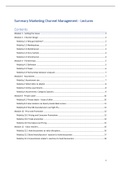Samenvatting
Summary lectures Marketing Channel Management 2021
- Instelling
- Tilburg University (UVT)
A clear summary of the lectures and tutorials for the course Marketing Channel Management, part of the MScs Marketing Management/Analytics at Tilburg University. If you have any questions, don't hesitate to ask! Note: the notes from the tutorials are incorporated in summary
[Meer zien]




